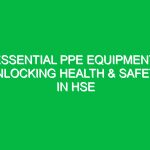Understanding What is a Risk in HSE
In the realm of Health, Safety, and Environment (HSE), the concept of risk plays a pivotal role in safeguarding workers, communities, and ecological systems. But what is a risk? In the HSE context, a risk refers to the potential for harm, injury, or adverse effects resulting from exposure to hazards. The importance of understanding risks cannot be overstated, as they inform the strategies and measures essential for preventing accidents and ensuring the well-being of individuals and the environment.
Every workplace, from construction sites to corporate offices, carries inherent risks. These can stem from physical hazards, chemical exposures, or even ergonomic issues. Recognizing and managing these risks is crucial not only for compliance with laws and regulations but also for fostering a culture of safety and responsibility. This article delves into the critical risks associated with HSE, exploring their implications and best practices for mitigation.
The Nature and Types of Risks in HSE
To grasp the significance of risk in HSE, it’s essential to categorize the types of risks present in various environments. The two primary types of risks are:
- Physical Risks: These involve hazards that can cause physical harm, such as falls, equipment malfunctions, and noise exposure.
- Chemical Risks: These arise from exposure to harmful substances, including toxic chemicals, dust, and fumes.
Furthermore, risks can be classified into several categories, including:
- Biological Risks: Associated with exposure to harmful organisms like bacteria and viruses.
- Ergonomic Risks: Related to workplace design that can lead to musculoskeletal injuries.
- Psychosocial Risks: Linked to workplace stressors, harassment, and work-life balance issues.
Identifying and Assessing Risks
What is a risk assessment? It is a systematic process to identify potential hazards in the workplace and evaluate the risks associated with them. This process typically involves several steps:
- Hazard Identification: This step involves recognizing potential hazards that could cause harm.
- Risk Analysis: Here, the likelihood of occurrence and the severity of consequences are evaluated.
- Risk Evaluation: This involves determining whether the risks are acceptable or require further control measures.
- Control Measures: Developing strategies to eliminate or minimize risks, such as implementing safety protocols or providing training.
For instance, a construction site may identify the risk of falls from heights as significant. By analyzing the likelihood of such an incident and its potential severity, safety managers can implement measures like harness systems and safety nets to mitigate this risk. The continuous cycle of risk assessment ensures that new hazards are identified and managed effectively.
Real-life Examples of HSE Risks
Understanding risks in HSE often comes alive through real-world examples. Consider the catastrophic Deepwater Horizon oil spill in 2010. The incident exemplifies how a failure to adequately assess and manage risks can result in significant environmental and economic repercussions. The explosion occurred due to a series of operational failures and inadequate safety measures, leading to the worst marine oil spill in history.
Another case is that of the Rana Plaza collapse in Bangladesh, where over a thousand garment workers lost their lives due to unsafe building conditions. Investigations revealed that the risk of structural failure had been ignored, highlighting the critical need for rigorous safety assessments in construction and manufacturing.
Mitigation Strategies for HSE Risks
Once the risks have been identified and assessed, the next step is implementing effective mitigation strategies. Here are some best practices:
- Training and Education: Regular training sessions help employees understand the risks associated with their tasks and the procedures to follow in case of emergencies.
- Personal Protective Equipment (PPE): Providing appropriate PPE is essential for minimizing exposure to hazards.
- Regular Safety Audits: Conducting periodic safety audits can help identify new risks and ensure compliance with safety protocols.
Moreover, fostering a culture of safety where employees feel empowered to report hazards without fear of reprisal can significantly enhance risk management efforts. Encouraging open communication about safety concerns can lead to a more proactive approach to mitigating risks.
Regulations and Standards Governing HSE Risks
Various regulations and standards exist to ensure that organizations effectively manage risks in the HSE domain. These include:
- Occupational Safety and Health Administration (OSHA): In the United States, OSHA sets and enforces standards to ensure safe working conditions.
- Environmental Protection Agency (EPA): This agency regulates environmental risks, ensuring that organizations comply with laws aimed at protecting the environment.
- ISO 45001: An international standard that specifies requirements for an occupational health and safety management system.
These regulations not only provide a framework for managing risks but also establish legal obligations for organizations. Compliance with these standards fosters a safer work environment and helps mitigate potential legal liabilities.
Conclusion: The Importance of Understanding Risks in HSE
In conclusion, understanding what is a risk within the HSE context is crucial for promoting safety and environmental sustainability. Risks are omnipresent in various environments, and their effective management requires a proactive approach. By identifying, assessing, and mitigating risks, organizations can protect their employees, communities, and the environment from potential harm.
As we strive for safer workplaces, ongoing education and awareness around risks are vital. By fostering a culture that prioritizes health, safety, and environmental stewardship, we can minimize risks and enhance overall well-being. The journey to a safer future begins with recognizing the critical risks in HSE and taking decisive action to manage them effectively.


